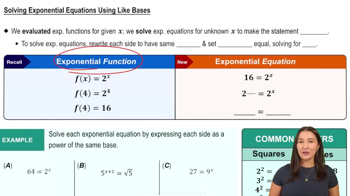Table of contents
- 0. Review of Algebra4h 16m
- 1. Equations & Inequalities3h 18m
- 2. Graphs of Equations43m
- 3. Functions2h 17m
- 4. Polynomial Functions1h 44m
- 5. Rational Functions1h 23m
- 6. Exponential & Logarithmic Functions2h 28m
- 7. Systems of Equations & Matrices4h 6m
- 8. Conic Sections2h 23m
- 9. Sequences, Series, & Induction1h 19m
- 10. Combinatorics & Probability1h 45m
6. Exponential & Logarithmic Functions
Solving Exponential and Logarithmic Equations
Problem 47a
Textbook Question
Solve each exponential equation in Exercises 23–48. Express the solution set in terms of natural logarithms or common logarithms. Then use a calculator to obtain a decimal approximation, correct to two decimal places, for the solution. 3^2x+3^x−2=0
 Verified step by step guidance
Verified step by step guidance1
Rewrite the equation in terms of a single variable by letting \( y = 3^x \). This transforms the equation into \( y^2 + y - 2 = 0 \).
Recognize that the equation \( y^2 + y - 2 = 0 \) is a quadratic equation. Use the quadratic formula \( y = \frac{-b \pm \sqrt{b^2 - 4ac}}{2a} \) to solve for \( y \), where \( a = 1 \), \( b = 1 \), and \( c = -2 \).
Calculate the discriminant \( b^2 - 4ac \) to determine the nature of the roots.
Solve for \( y \) using the quadratic formula, which will give you two potential solutions for \( y \).
Since \( y = 3^x \), solve for \( x \) by taking the logarithm of both sides for each solution of \( y \). Use either natural logarithms (\( \ln \)) or common logarithms (\( \log \)) to express \( x \) in terms of logarithms.
Recommended similar problem, with video answer:
 Verified Solution
Verified SolutionThis video solution was recommended by our tutors as helpful for the problem above
Video duration:
3mPlay a video:
Was this helpful?
Key Concepts
Here are the essential concepts you must grasp in order to answer the question correctly.
Exponential Equations
Exponential equations are equations in which variables appear as exponents. To solve these equations, one often needs to manipulate the equation to isolate the exponential term, allowing for the application of logarithms. Understanding the properties of exponents, such as the product, quotient, and power rules, is essential for simplifying and solving these types of equations.
Recommended video:

Solving Exponential Equations Using Logs
Logarithms
Logarithms are the inverse operations of exponentiation, allowing us to solve for the exponent in an exponential equation. There are two common types of logarithms: natural logarithms (base e) and common logarithms (base 10). Knowing how to convert between exponential and logarithmic forms is crucial for solving exponential equations, as it enables us to express solutions in a more manageable form.
Recommended video:

Logarithms Introduction
Calculator Use for Approximations
Using a calculator to obtain decimal approximations is an important step in solving exponential equations. After expressing the solution in terms of logarithms, a calculator can provide numerical values that are often necessary for practical applications. Understanding how to input logarithmic expressions into a calculator and round results to a specified number of decimal places is essential for accuracy in solutions.
Recommended video:

Solving Exponential Equations Using Logs

 4:46m
4:46mWatch next
Master Solving Exponential Equations Using Like Bases with a bite sized video explanation from Callie
Start learningRelated Videos
Related Practice












